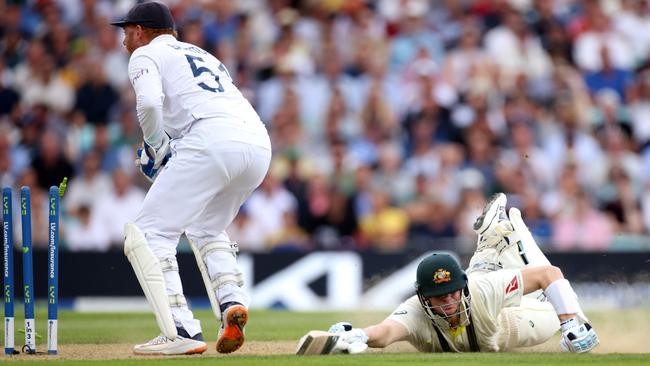Ashes: The best in this Test at The Oval may be yet to come

No plan, reputedly, survives contact with the enemy, and Australia’s proved no exception. As Usman Khawaja and Marnus Labuschagne eked 21 runs out the first hour under low cloud and in dim light, their objective was clear: attempt to put back into the game the time England had taken out the previous day, mindful that batting would become easier in the afternoon as bowlers tired and the ball softened.
These were touch-and-go conditions, for sure. Khawaja glanced a boundary when Anderson’s inswinger got too straight; Khawaja was beaten when Anderson’s away singer channelled fifth stump; he found fielders with crisp shots, could find no force in gaps. But as Labuschagne also sank into introspection, both batters found themselves isolated, almost in separate and parallel games.


Mike Brearley tells a story of sitting with a group of former greats as a fast bowler worked over an English opener. The agony continued, over upon over, until at last the paceman took a spell, whereupon it was agreed that the batter had done well to outlast his opponent. The one note of demurral came from Sir Leonard Hutton. “Aye,” said. “Mind you, a good batter would’ve bin at t’other end.”
Labuschagne could not find a way to get there, nor Khawaja to engineer it. He faced 82 balls, 31 from the joltingly rapid Wood, one of whose deliveries knocked Jonny Bairstow off his feet.
In Wood’s tenth over, Labuschagne might have scuttled a single to Stuart Broad, a little deep and a little less limber than he used to be at mid-on; Khawaja was unbudging, even turning his back slightly.
Bairstow was also unbudging a few balls later when Labuschagne nicked, but Root timed his dive to the left perfectly: though he has shelled some straightforward ones lately, this was probably the catch of the summer.
Smith immediately drove soothing consecutive boundaries down the ground from Anderson, and otherwise looked of a different quality to anything else on show. “The Oval”, where he averages in the vicinity of 100, might be carved on his heart like “Calais” on Mary I’s. But England could work around him, and made the post-lunch session their own with perhaps their best bowling, fuller and to more or less conventional fields, of the series.
Bowlers have a variety of demeanours as they return to the end of their marks: grim, relaxed, solemn, detached. James Anderson’s inscrutable walk back is almost a continuation of his trim and economical action.

I am partial to Broad’s: unfailingly cheerful, like a man on a brisk walk down a familiar country road, lightly on the balls of his feet. He’ll have a chat to the non-striker, to mid-off, to the umpire (often enough about the condition of the ball); he’ll look up at the scoreboard and the video screen; winding up spectators is a speciality. Seizing first over after the break, he was almost jogging back, so eager was he for the fray: he had a ball suddenly doing tricks, a crowd bubbling, and a left-hander in Khawaja to prise open.
When Kumar Dharmasena granted him an lbw against Khawaja, upheld on review, Broad stayed for a yarn, clapped the umpire on the shoulder companionably a couple of times.
Twice he beat Travis Head on the outside, locked eyes with him, studied the replay on the way back, nodded his head, clapped his hands, polished the ball with an extra flourish. Head was almost stationary as he nicked the next.
After the austerity of the first session, a flash of colour, movement and cheer. Marsh arrived in the pink of form, and Bazballed a six over Broad’s head. Broad looked a bit miffed, then appreciative. Bring it on.
In the event, Broad’s old mucker Anderson worked one through Marsh’s unpadlocked gate, and Root coaxed Carey into an indiscreet drive. When Starc top edged a cramped pull shot from Wood, Australia had lost six for 94 in 30 overs – more a general subsidence than a collapse, but a gaping opportunity for the hosts.



It was not quite England’s fault it went unseized. When he was 42, Smith careened back for a second run on the arm of substitute George Ealham, unknown to fame but grandson of a splendid fielder for Kent. Balham’s throw, skimmed over the square, was brilliant; the decision, to be frank, was not, tediously searching for the skerrick of a smidgen of a scintilla of doubt.
But there was all Smith in the dive to save himself: perfectly timed, fully elongated, bat-holding arm telescoped ahead of him. He can’t practice diving for the crease, surely? Strangely, it’s almost plausible that he does.
This proved the day’s hinge point: had the decision gone England’s way, Australia would have been 90 runs short with only a couple of tailend wickets remaining and the new ball due. As it was, Smith and Cummins extended their partnership to 54 in 103 balls. Nor did Stokes’ plan against Australia’s tail survive contact with the enemy.
Why have Wood pitch a 13-over-old ball halfway down the pitch with two men back and no slips to a batter averaging 10 in Test cricket when a fuller length had been so successful all day? Todd Murphy swivelled into three pull shots, all of them for six, and shaped so well that Australia secured the lead. Stokes ended the day on a more characteristic note, catching his opposite number at long-on with oaken strength and immense presence of mind. But the best in this match may be to come.






Another day; another Test match too close to call, after a morning, afternoon and evening at the Oval that unfolded like a pitched battle, with phases of stalemate, breakthrough and regrouping, as Australia’s first innings more or less cancelled out England’s, albeit at wholly different tempo.